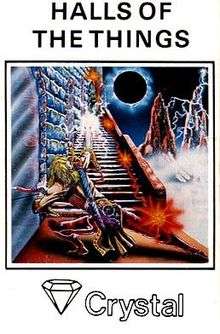Halls of the Things
Halls of the Things is a video game developed by Design Design for the ZX Spectrum and released by Crystal Computing in 1983. It was ported to the Amstrad CPC amd Commodore 64. The player travels through seven floors of a tower, searching for seven rings, with each floor being a complex maze of corridors and rooms. Once the player has the rings they must then find the magical key hidden in the dungeon, which opens the drawbridge allowing the player to escape. To hinder the player's progress they are attacked by "things," but the player is armed with a sword, arrows, fireballs and lightning to aid you in the quest.
| Halls of the Things | |
|---|---|
 Cover art by Dave De Leuw | |
| Developer(s) | Design Design |
| Publisher(s) | Crystal Computing |
| Programmer(s) | Neil Mottershead Simon Brattel Martin S. Horsley |
| Platform(s) | ZX Spectrum, Amstrad CPC, Commodore 64 |
| Release | 1983 |
| Genre(s) | Action |
The game was re-released by Design Design Software and Firebird Software. A sequel, Return of the Things, was released in 1984.
Reception
| Reception | ||||||||
|---|---|---|---|---|---|---|---|---|
| ||||||||
The game was well received when it was released.
"Excellent and dangerously addictive it could change the Spectrum games scene overnight". Sinclair User[1]
"Spectacular. One of the best games i've seen, finely balanced between simplicity and addictiveness - superb graphics and colour - I CAN'T RECOMMEND IT HIGHLY ENOUGH". Popular Computing Weekly[3]
ZX Computing magazine, featured Halls of the Things as the best game of 1983.[4] The ZX Spectrum version was voted the 27th best game of all time in a special issue of Your Sinclair magazine in 2004.[5]
References
- "Review". Sinclair User (17): 32. August 1983.
- "Zzap! Budget Test". Zzap!64. No. 37. May 1988. p. 89.
- "Review". Popular Computing Weekly. 1983.
- "Feature". ZX Computing (8312): 151. December 1983.
- "Top 50 Games of All Time". Your Sinclair. Imagine Publishing. November 2004.
External links
- Halls of the Things at SpectrumComputing.co.uk
- Halls of the Things at Lemon 64
- Halls of the Things original source code at Design Design